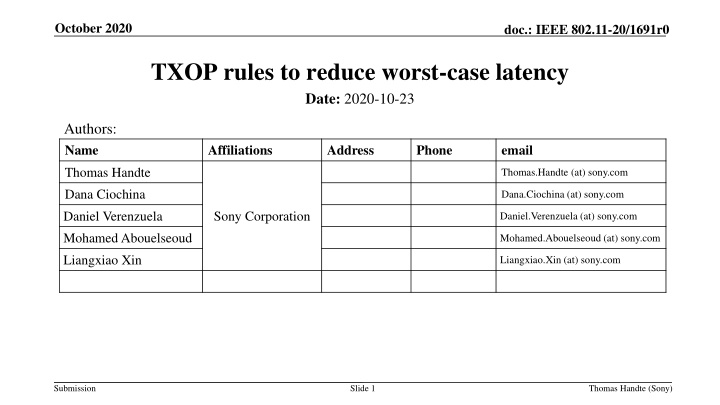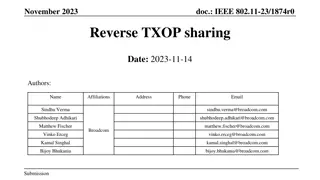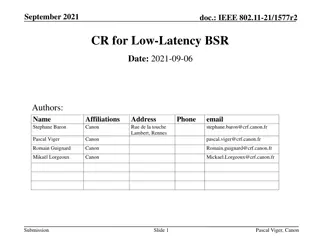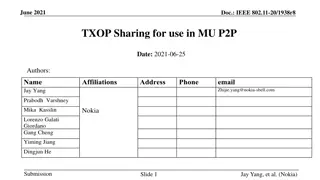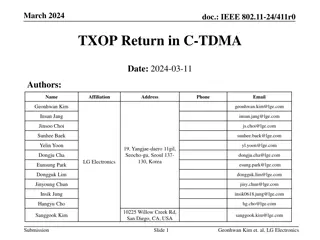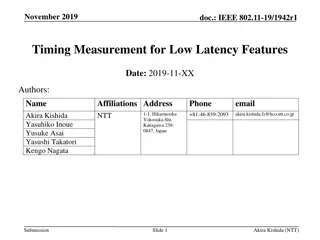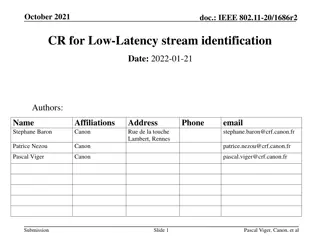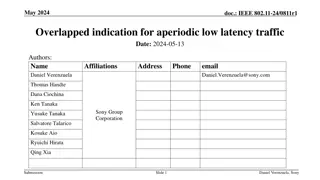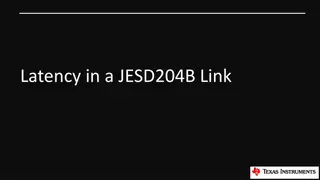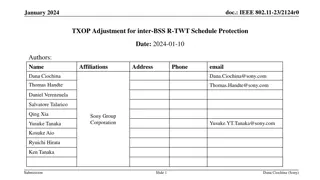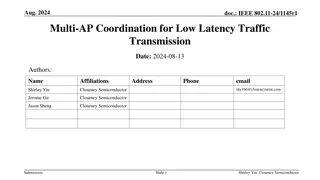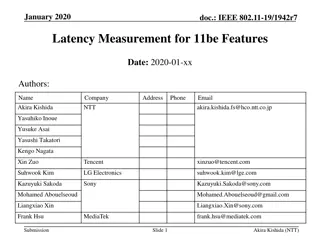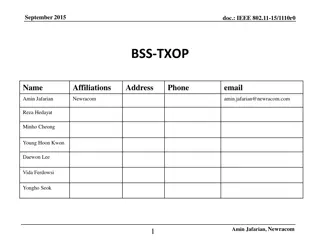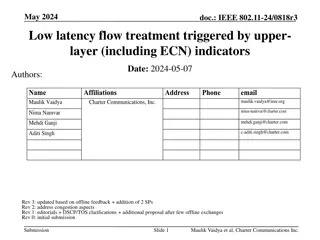IEEE 802.11-20/1691r0 TXOP Rules to Reduce Worst-Case Latency
This document discusses proposals aimed at reducing average and worst-case latency in low latency services provided by IEEE 802.11be. It addresses issues related to retransmissions and outlines new rules for TXOP configuration to improve response times in case of missing responses.
Download Presentation

Please find below an Image/Link to download the presentation.
The content on the website is provided AS IS for your information and personal use only. It may not be sold, licensed, or shared on other websites without obtaining consent from the author.If you encounter any issues during the download, it is possible that the publisher has removed the file from their server.
You are allowed to download the files provided on this website for personal or commercial use, subject to the condition that they are used lawfully. All files are the property of their respective owners.
The content on the website is provided AS IS for your information and personal use only. It may not be sold, licensed, or shared on other websites without obtaining consent from the author.
E N D
Presentation Transcript
October 2020 doc.: IEEE 802.11-20/1691r0 TXOP rules to reduce worst-case latency Date: 2020-10-23 Authors: Name Affiliations Address Phone email Thomas Handte Dana Ciochina Daniel Verenzuela Mohamed Abouelseoud Liangxiao Xin Thomas.Handte (at) sony.com Dana.Ciochina (at) sony.com Sony Corporation Daniel.Verenzuela (at) sony.com Mohamed.Abouelseoud (at) sony.com Liangxiao.Xin (at) sony.com Submission Slide 1 Thomas Handte (Sony)
October 2020 doc.: IEEE 802.11-20/1691r0 Introduction (1/2) Low latency service is an important application scenario for 11be Various submissions addressed Indication of low latency traffic [1-4] Protected period for low latency traffic [3,5,6] New EDCA queue [4,7] Scheduling provision information [8,9] QoS negotiation [1,3] TXOP resource agreements [10] The goal of these proposals is to reduce average and/or worst-case latency Some target to limit retransmissions by e.g. protected period However, retransmissions may still occasionally happen e.g. due to collisions or rate sounding Retransmissions have large impact to worst-case latency Goal of this submission is to provide improvements to existing technology in missing response case Submission Slide 2 Thomas Handte (Sony)
October 2020 doc.: IEEE 802.11-20/1691r0 Introduction (2/2) Current behavior in missing response case depends on the position of the failed PPDU within a TXOP [11] If the failed PPDU is the initial PPDU within a TXOP, a STA a) Invokes backoff procedure with incremented CW[AC] If the failed PPDU is a non-initial PPDU within a TXOP, a STA has the following options b) Perform PIFS recovery, Continue if CS mechanism indicates idle at TxPIFS boundary and remaining TXNAV is sufficient c) Invoke backoff procedure within same TXOP with incremented CW[AC], or d) Wait for TXNAV timer to expire and perform backoff with CW[AC] = CWmin[AC] Suitability for low latency traffic Anything that causes a STA to increment CW[AC] is harmful as it potentially provides various TXOPs to other ACs or STAs This applies for option a), option c), or option b) if CS mechanism indicates non-idle Option d) may be suitable if missing response occurs towards the end of a TXOP Focus of this submission are options a), b), or c), i.e. the cases when A missing response occurs to an initial PPDU within a TXOP A missing response occurs to a non-initial PPDU within a TXOP and the channel is detected as busy Submission Slide 3 Thomas Handte (Sony)
October 2020 doc.: IEEE 802.11-20/1691r0 Goal of the submission This submission provides new rules for TXOP configuration to mitigate worst case latency The rules are applicable for the missing response case under the conditions of previous slide i.e. if a STA increments its CW[AC]. Example for a missing response STA A transmits a PPDU to STA B that requires a response A response frame is not received by STA A STA A initiates backoff procedure and retransmits data Definition of a new behavior of STA A in case of a missing response The new behavior is applicable for the AC in which the collision was caused, or all ACs except the AC in which the collision was caused Regular behavior applies once retransmission was successful or related MSDU lifetime is exceeded Submission Slide 4 Thomas Handte (Sony)
October 2020 doc.: IEEE 802.11-20/1691r0 TXOP content restriction (1/2) Issue Once a new TXOP is obtained by STA A, it may hold not only retransmitted data but also other data e.g. from same or other TID This behavior is favorable to maximize throughput, but causes latency Latency is caused to STA A s own link, if latency is measured until BAck is received Other links if a collision was the reason for the backoff Example Submission Slide 5 Thomas Handte (Sony)
October 2020 doc.: IEEE 802.11-20/1691r0 TXOP content restriction (2/2) Solution Restrict content of a TXOP after a missing response Two options for a TXOP to contain no more than retransmitted data retransmitted data and data of previously agreed TIDs (e.g. same TID) if available Benefits Avoids delay until a response is received Allows other STA to access medium sooner in case of a collision Example Submission Slide 6 Thomas Handte (Sony)
October 2020 doc.: IEEE 802.11-20/1691r0 TXOP shortening (1/2) Scenario A STA has low-latency traffic and best-effort traffic mapped to different ACs, e.g. AC_VO and AC_BE Issue The TXOP of other ACs impedes retransmission in a missing response case Assume LL_AC to be any AC that contains data to be retransmitted, e.g. of a low latency TID If an AC other than LL_AC is first to transmit and has a full queue, its TXOP impedes retransmission Note that TXOP sharing is not applicable because primary AC has non-empty queue Submission Slide 7 Thomas Handte (Sony)
October 2020 doc.: IEEE 802.11-20/1691r0 TXOP shortening (2/2) Solution Reduce TXOP limit of ACs other than LL_AC in case LL_AC holds data to be retransmitted Extent of shortening is TBD Could be a function of retry counter, e.g. TXOP_limit(AC) = TXOP_limit0AC 2 QSRC LL_AC with AC LL_AC i.e. TXOP limits is halved with every retransmission Benefits Time in between CW count downs gets lower, hence time until retransmission lowers Allows the LL_AC to get channel access sooner Submission Slide 8 Thomas Handte (Sony)
October 2020 doc.: IEEE 802.11-20/1691r0 Effect of the proposed rules (1/2) The proposed rules allow to balance between throughput and latency TXOP utilization reduces; hence throughput lowers due to more fragmented channel access However, latency improves in the critical situation of a missing response There are two sources of the latency gain Self-induced, i.e. a STA that applies the TXOP rules has a latency advantage E.g. BAck arrives earlier or can retransmit earlier Induced by other STAs, i.e. a particular STA can transmit earlier because another STA applies the TXOP rules E.g. earlier chance to retransmit after a collision Submission Slide 9 Thomas Handte (Sony)
October 2020 doc.: IEEE 802.11-20/1691r0 Effect of the proposed rules (2/2) Sometimes behavior of some STAs can not be influenced, e.g. legacy STA or OBSS STA The self-induced latency gain is still present, but what is the impact of STAs not following the proposed TXOP rules? Analysis of two scenarios Scenario A STA-A and STA-B apply the proposed TXOP rules STA-A and STA-B are missing a response from their peer STAs due to a collision Performance of each STA is given in comparison to both STAs using current TXOP rules Scenario B As Scenario A, but STA-A uses existing TXOP rules (e.g. legacy STA), STA-B applies the proposed TXOP rules Scenario A Scenario B Latency TXOP utilization Latency TXOP utilization STA-A Advantage Reduced for traffic not related to retransmission STA-A Advantage Unchanged STA-B Advantage Reduced for traffic not related to retransmission STA-B Unchanged Reduced for traffic not related to retransmission In scenario B, the disadvantage of STA-B may be balanced by setting different TXOP limit for (legacy) STA-A Submission Slide 10 Thomas Handte (Sony)
October 2020 doc.: IEEE 802.11-20/1691r0 Simulation (1/3) Simulation Scenario 2 STAs transmitting uplink traffic to an AP Both STAs have full buffer EDCA AIFSN=3, CWmin=15, CWmax=1023 Initial max TXOP duration is 5.5ms Minstrel rate adaption Shortened max TXOP duration is 2.8ms STA-A follows the TXOP rules, whereas STA-B does not Analysis of the latency gain of STA-B induced by STA-A for a latency metric measured without (w/o) Ack response or with (w/) Ack response STA-A AP STA-B Submission Slide 11 Thomas Handte (Sony)
October 2020 doc.: IEEE 802.11-20/1691r0 Simulation (2/3) Proposed rules reduce worst-case latency Difference plays out for CDF>0.9 as a missing response is a prerequisite for the TXOP rule to be applied Reference [12] Submission Slide 12 Thomas Handte (Sony)
October 2020 doc.: IEEE 802.11-20/1691r0 Simulation (3/3) Gains are the order of 0.5 to 6ms for the considered scenario Corresponds to 2% to 16% Tendency is that TXOP content restriction achieves smaller gain than TXOP shortening The retransmission goes into two TXOPs, because rate adaption lowers MCS First TXOP has unchanged size but only the second is shortened. The likelihood that a TXOP of the considered STA with retrans- mitted data comes after the second TXOP is small. With TXOP shortening, all TXOPs are shortened, increasing the likelihood that a TXOP of the considered STA comes after at least one shortened TXOP. Gain certainly depends on How many STAs are part of the collision domain For large collision domain triggered access or TWT is favorable How many STAs are following the new TXOP rules TXOP shortening parameters (here length is halved) gain 3-6ms 3.5-6ms 1-2ms 1-2ms 2.5-3ms 0.5-1ms Submission Slide 13 Thomas Handte (Sony)
October 2020 doc.: IEEE 802.11-20/1691r0 Applicability The effectiveness of the proposed rules depends on traffic type, applied ACs, environment, and overall traffic load Applicability of the proposed TXOP rules should be adjustable to requirements and constraints Legacy STA can be controlled by setting a different (lower) TXOP limit AP or STA may negotiate with its peer the applicability for its traffic streams among other parameters The negotiation may be part of low-latency or RTA session initiation Negotiation/ signaling is TBD ADDTS request/response or scheduling session [8,9] could be reused A bitmap could be envisioned to indicate applicability of each rule Applicability should be made TID or AC specific (TBD) Submission Slide 14 Thomas Handte (Sony)
October 2020 doc.: IEEE 802.11-20/1691r0 Conclusion TXOP rules as defined today may hinder low latency service It is important to revisit how a TXOP is configured after a missing response We propose two rules for TXOP that alleviate low latency service TXOP content restriction After a missing response, the TXOP that contains the retransmitted data shall contain no more than the data to be retransmitted, except data from agreed TIDs TXOP shortening After a missing response, the maximum TXOP duration of ACs other than the one that suffered a missing response, shall be shortened Benefits Lower latency until successful response to retransmission Earlier chance to retransmit in collision case Both rules allow to balance throughput in favor of latency Applicability AP and STA may negotiate appropriate settings according to requirements and constraints Submission Slide 15 Thomas Handte (Sony)
October 2020 doc.: IEEE 802.11-20/1691r0 Straw Poll #1 Do you agree to add the following to the TGbe SFD? An AP may request a STA for a TID mapped to any AC0 to restrict the content of a TXOP of AC0 to contain only MPDUs with retry subfield set to 1 and any required acknowledgements, if - no response frame was received for a transmitted PPDU that contained at least one MPDU soliciting an immediate response frame, and - the missing response frame caused the transmitting STA to increment CW[AC0]. The restriction is valid until no more MPDUs are pending for retransmission for the requested TID within AC0 or related MSDU lifetime is exceeded. Submission Slide 16 Thomas Handte (Sony)
October 2020 doc.: IEEE 802.11-20/1691r0 Straw Poll #2 Do you agree to add the following to the TGbe SFD? An AP may request a STA to shorten the maximum TXOP duration of one or more ACs, if - no response frame was received for a transmitted PPDU that contained at least one MPDU soliciting an immediate response frame, and - the missing response frame caused the transmitting STA to increment CW[AC0]. The shortened maximum TXOP duration is applicable for all agreed ACs except AC0. The shortened maximum TXOP duration is valid until no more MPDUs are pending for retransmission in AC0 or related MSDU lifetime is exceeded. - Extent of the TXOP shortening is TBD - If this rule is applicable for all TIDs mapped to AC0 is TBD Submission Slide 17 Thomas Handte (Sony)
October 2020 doc.: IEEE 802.11-20/1691r0 References [1] 11-20/418r4 Low latency service in 802.11be [2] 11-20/463r3 Priority Access Support Options for NS/EP Serveices [3] 11-20/163r1 Low Latency Enhancements for R1 [4] 11-19/1175r0 Channel Access Category [5] 11-20/1350r0 Enhancements for QoS and low latency in 802.11be R1 [6] 11-20/1046r4 Protected TWT Enhancement for Latency Sensitive Traffic [7] 11-20/1041r2 EDCA queue for RTA [8] 11-20/1006r1 New Methods To Meet Low Latency Requirement [9] 11-20/1076r0 Traffic indication of latency sensitive applications [10] 11-20/1670r0 Low Latency resource agreements [11] Draft P802.11REVmd_D4.0 [12] 11-19/1298r1 IEEE 802.1 TSN An Introduction Submission Slide 18 Thomas Handte (Sony)
